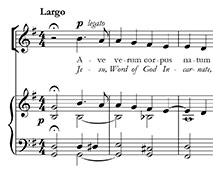 (Download links are at the end of the review.)
(Download links are at the end of the review.)
There are many appropriate anthems that commemorate the Last Supper and the words of Christ as quoted in 1 Corinthians 11:23-26: This is my body which is for you. This cup is the new covenant in my blood. For as often as you eat this bread and drink the cup, you proclaim the Lord’s death until he comes.
Possibly the most historic text associated with this scripture comes from the 14th century, a communion hymn known by its Latin title Ave Verum (Corpus). As all church music at the time used Latin texts, this anthem can be sung in its original language or in an English translation (Jesu, Word of God Incarnate). If the Latin is sung, an English translation should be given in the bulletin for the congregation to read.
Responsive to the familiarity of this text and the truths it so poignantly expressed, composers of many nationalities and time periods have set it to music. The most famous setting is by Wolfgang Amadeus Mozart (K. 618) in the 18th century. Other settings are by Orlando Lassus, William Byrd, Franz Liszt, Camille Saint-Saens, Alexandre Guilmant and numerous composers from the 20th century, including Malcolm Arnold, Imant Raminsh, Stephen Harrap, and Michael Sitton.
English composer Edward Elgar (1857-1934) has the simplest and most beautiful of all the settings and it is not to be missed: Ave Verum by Edward Elgar, Op. 2, No. 1, 1887, revised 1902, Anthem for SATB voices with keyboard accompaniment.
This composition can be sung by any sized choir, may be downloaded free from CPDL because it is in the public domain, and is appropriate for Maundy Thursday, Good Friday, or any Communion service. If this text has never been heard by your congregation, the upcoming Maundy Thursday service is the perfect occasion to introduce it. Think, for a moment, how fortunate we are as 21st-century Christians to be able to sing a text that has been sung by the saints for six centuries. Is this not a remarkable and humbling experience to join with saints past and present in celebrating the Eucharist through this text?
If you are not familiar with the anthem’s text, it reads: Jesu, word of God incarnate, of the Virgin Mary born, on the cross thy sacred body for us with nails was torn. Cleanse us, by the blood and water streaming from thy pierced side. Feed us with thy body broken, now, and in death’s agony. O Jesu, hear us, son of Mary.
Elgar’s musical setting is in A B Coda form. A soprano soloist (or all female voices) sings the first phrase of text with melody and text repeated by the choir in a simple, SATB chordal version. The B section (Cleanse us) follows the same format: soloist followed by repetition of music and text by choir. The Coda is only six measures long and begins O Jesu. Elgar uses a simple antiphonal effect between sopranos/tenors and altos/basses to begin the Coda and ends the section with four-part chords (Son of Mary) that are lush, chromatic, and movingly expressive of the text. The vocal range of the piece is very modest, and the dynamic level is mostly very quiet and expressive. The 39-measure composition is accompanied throughout by sustaining chords in the keyboard.
There is a 1986 published version of Elgar’s anthem edited by Philip Brunelle for Boosey & Hawkes. This version and most of the other settings by the composers previously mentioned, can be found in the CMI eLibrary. (Find Scriptural, Lectionary, and Liturgical References along with other data on the CMI eLibrary online catalogue for these anthems.)
The good news is Elgar’s beautiful setting of the anthem can be downloaded from CPDL (Composer’s Public Domain Library) free of charge! The CPDL version (also found in the eLibrary catalogue) is edited by Toby Wardman (#10009), is identical to the Brunelle edition. You can download the PDF for free from the CPDL website (links below). There is no excuse for failing to sing this anthem!
You are now ready to introduce this wonderful little gem to your choir and discover the spiritual rewards it offers. May blessings abound as you find a place for it in your worship experience!
Robert C. Mann, D.M.A.
Resource Library Director
Church Music Institute